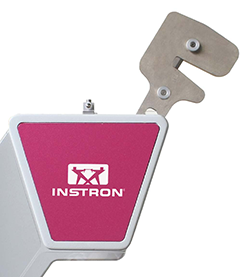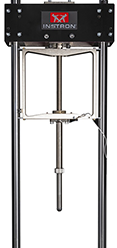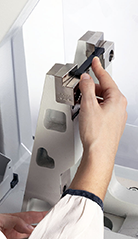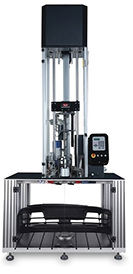Pendulum Impact Testing machines and Drop Towers are both critical to validating the performance of materials. They are used to determine a material’s resistance to an impact event. Both types of impact systems can test a variety of materials, including plastics, polymers, and light alloys. However, there are differences between the two instruments that determine which application is best suited to each. Here are some key considerations.
What’s the difference between a Pendulum Impact Testing machine and a Drop Tower?
A pendulum impact tester and a drop tower both measure the energy absorbed when an external object strikes a sample specimen. However, each test uses a different approach.
As the name implies, a pendulum uses a hammer (mass) rotating on an axis to strike a sample. The point of impact occurs at the lowest point of the pendulum arc when the force is only directed in the horizontal plane.

In a drop tower, a mass is dropped on a sample, and the impact is measured using a load cell. The force of impact is directed in the vertical plane only. Unlike pendulums, drop towers can also measure deformation, thus giving more information about the material properties.

Know your Standards
The first step to determining whether to use a pendulum or a drop tower is knowing the standards that the test needs to comply with.
There are two traditional standards for measuring impact resistance: the Charpy pendulum impact test (ISO 179/ASTM D6110) and the Izod test (ISO 180/ASTM D256). These two test methods are used to certify the impact resistance of a variety of materials, including metals as well as plastics, resins, and composites. They are often found on data sheets to show that the material conforms to its specifications.
Neither Charpy nor Izod test standards allow for the use of drop towers except for the ISO 179-2 standard. This limitation means that only pendulum impact testers may be used to certify products according to ISO 179-1/ASTM D6110 and/or ISO 180/ASTM D256.
Drop towers can still be used to perform Charpy and Izod tests for internal purposes (e.g., to compare products or investigate material properties). Not only that. Drop towers offer greater flexibility than pendulums when it comes to testing configurations and can test according to a variety of standards, including:
- ISO11343 – Adhesives – Wedge Impact Method
- ISO 8256 – Determination of Tensile Impact Strength
- ISO 6603-2 and ASTM D3763 - High Speed Puncture Properties of Plastic
- ASTM D7136 - Measuring Damage Resistance in Composites to Drop Weight Impact Event
Drop towers can also be used to perform custom tests that go beyond the requirements of international standards. For example, automotive OEMs often have their internal test requirements that call for the use of drop towers.
Testing materials vs. finished products
Charpy and Izod tests have precise requirements for sample specimens. The dimensions, position, and size of the notch are all specified in the test methods. Pendulum impact testing machines are configured with these requirements in mind, including their point of impact and specimen housing. Pendulums are therefore ideally suited to perform Quality Control (QC) tests on specimens of raw materials and composites.

However, it is challenging to use a pendulum to test a finished product or part. The non-standard shape of the specimen makes it difficult to place the notch in the correct location and orientate the sample for the correct point of impact. The pendulum impact machine is simply not designed for these applications.
Testing the impact characteristics of finished products and parts is critical to understanding their performance under real-world conditions. This is where the drop tower proves invaluable. Flexible configurations allow for any shape sample specimen so that researchers can compare the performance of products made with different materials.

Different materials, different testing requirements
We’ve seen how pendulums are often used to perform QC tests on a range of raw materials. However, advanced materials such as high-performance polymers may require drop tower testing as well. These lightweight materials enable improved fuel efficiency and, therefore, lower emissions, which makes them a great fit for automotive and aerospace applications. These industries have very stringent requirements when it comes to material properties.
Some automotive OEMs, for example, demand puncture tests performed on a drop tower as a requirement for the supply of raw materials. Even though this test may not be performed as often under international quality specification, OEMs are setting their internal quality requirements to meet the robust demands of their industry. This is often in addition to the standard certification tests using pendulum instruments.
Material type and applications aren’t the only factors to consider when choosing between a drop tower and a pendulum. Material properties are also important. Generally, drop towers can test materials like polyolefins that exhibit ductile behavior. Pendulum-type testers are the optimal choice for brittle-fracture materials, like many engineering thermoplastics used in metal replacement applications.
Sometimes both drop towers and pendulums are deployed to test the same materials at different stages of their development. Some raw material producers, for example, may use instrumented drop towers to test high-impact, glass-reinforced compounds as part of the research and development (R&D) process. They would then deploy a non-instrumented pendulum impact tester to conduct Izod/Charpy QC tests on the same materials.
From R&D to QC: using drop towers and pendulum testers at the different stages of the manufacturing process
Ultimately, pendulum impact testers and drop towers both have a vital role to play in impact testing. They are complementary solutions that can be used at different stages of the manufacturing process.
The features and benefits of drop towers make them ideally suited to the R&D environment. The main reason for this is flexibility. You can use a sample of any shape, and you can set the instrument to strike the sample at any point. This flexibility allows chemists and researchers to make prototypes and then test their performance. They can compare specimens made from different materials and the effect of changes in their design.
QC laboratories work with standard methods, meticulous sample preparation, and repeatable results. Generally, the pendulum impact tester is best suited to this environment. Only the pendulum machine conforms to the requirements of Charpy and Izod, making this instrument an essential element of product certification.